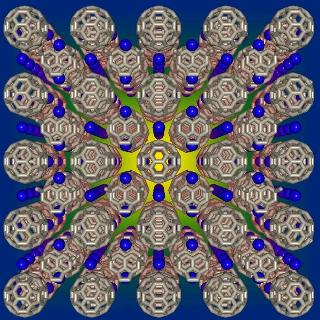Apr 20 2015
Professor Kosmas Prassides of Tohoku University, has led an international team of researchers who have discovered a new state of matter called as the Jahn-Teller metal. In this state, localized electrons on the fullerene molecules demonstrate co-existence with metallicity.
 Image Credit: Prassides Kosmas
Image Credit: Prassides Kosmas
Among molecular superconductors, fullerenes are considered to have the highest known superconducting critical temperature (Tc). The international research team studied the electronic properties of fullerene-based family of unconventional superconductors.
They successfully demonstrated the molecular electronic structure’s guiding influence for controlling superconductivity and also in helping achieve the maximum Tc. This discovery opens a new pathway for discovering high Tc superconductors.
Metals are commonly used for transmission of electricity. However, as they have electrical resistance, energy loss takes place in the form of heat. Superconductors have the ability to carry electricity without any loss of energy as they do not have any electrical resistance. Hence, it would be very fruitful to discover superconductors that have the ability to function at the highest possible temperature.
Superconductors usually have a simple structure, and they are built from atoms. However, recently, researchers have discovered some superconductors that are made up of molecules that are arranged in regular solid structures.
Earlier, when the research team had been conducting studies on molecular fulleride-based systems, they had discovered that 38K was the highest working temperature that was demonstrated by a molecular superconductor. This finding had been published in Nature Materials journal.
The electronic ground state was magnetically ordered. This electronic ground state competes with superconductivity. This finding had been reported in Science. Using external pressure, the C60 molecule arrangement in the solid can be tuned for switching on the zero-resistance superconducting state. This finding had been reported in Nature.
The researchers then identified the molecular electronic structure’s controlling role. They showed that the parent insulating state was connected to Jahn-Teller distortion of the molecular anions. These produced the magnetism from where the superconductivity comes forth. This result had been reported in Nature Communications.
In the current study, the researchers analyzed a new family of chemically-pressurized fullerene materials. They studied the relationship that existed between the superconducting pairing mechanism, the normal metallic state above Tc, and the parent insulator in these materials. This is a critical question that would help know about unconventional superconductors, which include heavy fermion systems, iron pnictides and high-Tc cuprates.
The new study revealed the Jahn-Teller metal, which is a novel state of matter. It demonstrated that when the balance at the Fermi level between electrons’ extended lattice and molecular characteristics was optimized, the highest possible temperature for superconductivity was achieved.
Synthetic chemistry facilitates the creation of new molecular electronic structures that are different from those in ions and atoms that are in usual superconductors. This has motivated interest to discover new molecular superconducting materials.
Professor Kosmas Prassides at Tohoku University's Advanced Institute for Materials Research is the team leader for this study. He was a former Professor at Durham University, UK. For the Research Leader of the Light Element Molecular Superconductivity (LEMSUPER) Project that is supported by the JST-EU Coordinated Research Project "Superconductivity" Prassides is the EU Research Leader, and for the JST-supported Isobe Degenerate-Integration Project of Exploratory Research for Advanced Technology (ERATO), he is an Independent Collaborating Principal Investigator.
Other groups of researchers involved in the study were Professor Yoshihiro Iwasa (Japan Research Leader of LEMSUPER Project) of the University of Tokyo; Professor Katalin Kamaras of the Hungarian Academy of Sciences; Professor Denis Arcon of the University of Ljubljana, Slovenia; and Professor Matthew J. Rosseinsky of the University of Liverpool, UK.
The synchrotron radiation X-ray facilities at SPring-8 (Japan) and the ESRF (France), were utilized in the research.
The JST-EU coordinated program - "Strategic International Collaborative Research Program” (SICORP) had provided funds for this study.
The results of the study titled “Optimized Unconventional Superconductivity in a Molecular Jahn-Teller Metal,” have been published in the scientific journal, Science Advances.